She was purchased from Bolson's yard in Poole, Dorset, who were given the job of selling off these redundant boats.
When bought she still had her torpedo tubes and mounts on, together with the forward gun mount, depth charge racks, exhaust silencers. In the engine room only the engines and propellors (three) and shafts had been taken out everything else was left.
My father was able to sell much of the brass, steel and copper which enabled him to finance the conversion.
Linnette had four cabins, a saloon, two part galley, two toilets, a workshop - originally the engine room. Her radio room became my den.
The wheelhouse, apart from having a door through which access was gained, was a comfortable "summer house" with her large and original windows we had a good view of the Lymington river and surrounding areas.
Linnette was very comfortable, snug and extremely warm in winter. The following photographs were taken by my late Father and give a good idea of how she looked.
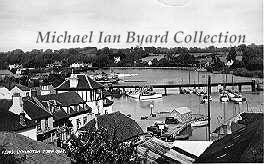
The Quay, Lymington circa 1953,
from a postcard of the time.
Lymington
River, above and below
(Town Quay side) the railway bridge which connected Lymington Town Station
with Lymington Pier, for the ferry to the Isle of Wight. Linnette is the
second boat beyond the Thames Spritsail Barge, above the bridge.
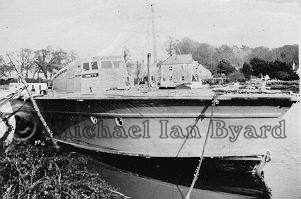
"Linnette" moored starboard side to the bank
at Lymington Slipway, Lymington, Hampshire. November 1947 to May 1953.
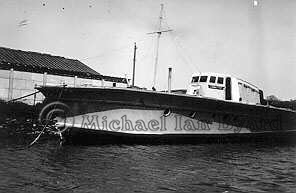
"Linnette"
viewed from the Port side at
Lymington Slipway, Lymington,
Hampshire. November 1947 to May 1953.
Linnette from the river.
The Saloon portholes, as well as those of my parents cabin, a little further aft, were put in by my father.
The Wheelhouse door, one of two entrances into the boat is shown, the other entrance was via the forepeak hatchway on her foredeck.
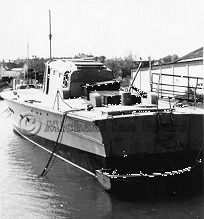
Stern view with my 9 foot sailing
dinghy "Brat" at her stern.
She was stripped of her naval paintwork, painstakingly burnt off to natural wood, then repainted in gloss white paint, with red waterline and dark green antifouling paint on her underwater hull. Cabins were built for my parents and myself, as well as a guest cabin.
To give natural light, brass portholes were fitted the cabins and in what became the saloon (loungeroom to landlubbers).
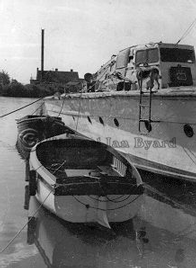
Linnette, Silvermere, Slipway Launch
and, on deck, "sea-dog" Julie, our
German Shepherd Bitch, who loved
a ride in the launch or dinghy.
Initially she was moored bow-on to the bank and her gang plank was fixed over her bow.
After
a few months she was
repositioned to be starboard side to the bank as shown above, and the
gang plank fixed on a roller so that it could rise and fall easily with
the tide.
Linnette is shown here with "Silvermere" our 18 foot motor launch, also painted in white. Ahead of her is moored the black works launch that my father often had to use.
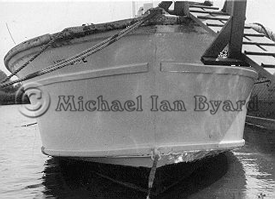
Linnette shown as originally moored,
bows tothe bank with the 'brow, or
gangplank' over her port bow.
Bow view of Linnette, from which can be seen her prominent "chine", and the brass letters of her name, beneath her bow mooring rope.
It was my job to clean the brass every week.
They were eventually mounted on two boards and placed on each side of the wheelhouse, as can be seen below.
When we migrated to Australia in 1953 that was the last that my parents saw of her.
I returned for a working holiday in January 1965 and she was still afloat but had been moved further up river nearer to the Lymington Town / Lymington Pier road. By this time someone had put tarmac on her deck.....a disgusting thing to have done and quite out of character.
When I finally returned to England in March 1973 I went to Lymington and found her wrecked and falling to pieces being covered by water at high tide.
I did, however, manage to salvage a couple of items including a small portion of her engine room hull, which I cleaned and varnished, so something physical of the "Little Ship" survives, and I have potted details of her war career, so that is something to remember her by!